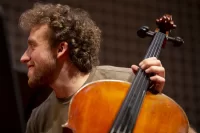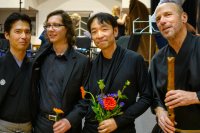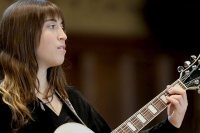
Bates student composers present thesis work in evening concerts
Music majors Ben Taska ’11, Peter Gurney ’11 and Alex Koster ’11 present their senior thesis compositions in 7:30 p.m. concerts this month in the Olin Arts Concert Hall, 75 Russell St.
Taska’s work will be performed on Sunday, April 10; Gurney’s on Friday, April 15; and Koster’s on Wednesday, April 27.
Taska has composed a score for the film “Little Otik,” a comedy combining live action and stop-motion animation by Czech director Jan Svankmajer. Based on the folktale “Otesánek,” the film shows a childless couple’s struggle to satisfy the cravings of a voracious stump that they have taken on as their “child.”
Hear an excerpt of a composition by Alex Koster based on the harmonic composition of a human voice.
” ‘Little Otik’ was just the right movie to score because the extreme overall craziness that reigns throughout seemed particularly exciting in terms of composition,” said Taska, of Lowell, Vt.
Taska notes that 20th-century composers such as Stravinsky and Debussy have influenced his work. Taska’s score contains percussion, French horn, piano, and four wind and four stringed instruments. The piece will be performed by students and visiting professionals led by Hiroya Miura, conductor of the Bates College Orchestra.
Gurney, of Arlington, Va., offers a program consisting of a six-movement piece for clarinet, played by Rose Pruiksma; piano (Chiharu Naruse); bassoon (Ardith Keef); and cello (Shannon Allen).
Koster, of Pound Ridge, N.Y., presents music that explores conceptual and extra-musical frameworks for composition. Musicians will perform three of his works, and the composer will present a fourth through computer-generated sound and a PowerPoint display.
Koster received an internal Bates grant, the Ruggles Scholarship, to support his research for the project. His thesis explores the use of non-musical elements, such as video or a harmonic analysis of the human voice, as both the substance and an organizing principle for musical composition.
One of the pieces to be played by live musicians, for example, uses the mapping of a video image as its basis. Meanwhile, the orchestral piece that Koster will present with computer software and PowerPoint is based on the electronic analysis of voices.
One section of the piece uses the rising and falling pitches of speech as source material. Another is derived from a fragment of speech broken down into its component harmonics, which Koster assigned to different synthesized instruments.
“There are many discrete overtones, with their own volumes, in the voice,” he says. “The relationship of all these frequencies and how they interact with each other make up the timbre of a voice.”
His original idea was to travel around the country recording voices with different accents, and compose music that would reveal those regional differences.
“That was a little difficult to achieve, but what I did find was a fantastic method for arriving at intriguing harmonies, and that was the real value of the project,” he notes.
“You have so much information in just one second of audio that I would take one person saying one word, and that would make a 10-minute piece,” he explains, “just fleshing out those ideas and expanding things in different ways.”
So that section of music is derived solely from a resident of the South saying “off.”




